Moonlight: cranked-amp tone at non-lethal volume
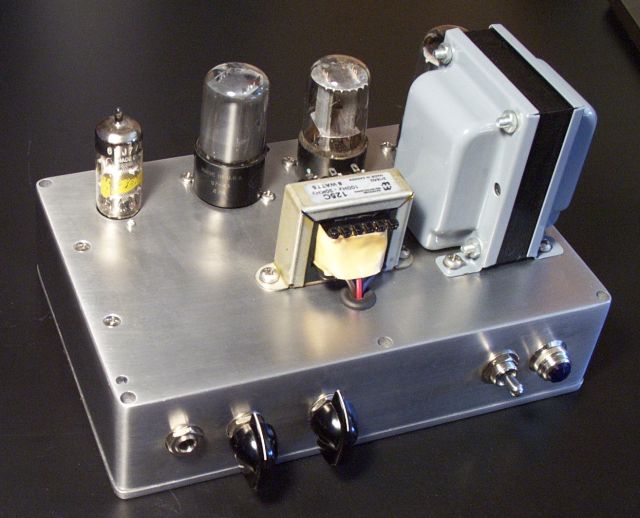
I constructed this mini-amp from Simcha (aka Stephen) Delft's excellent Moonlight design. Schematics, layout, and sound clips were fomerly available at AX84, but for various reasons, the Moonlight is no longer an AX84 project. Here is the schematic, turret board layout, and chassis layout as I built it. The original design used Simcha's own hand-wound power and output transformers, which she no longer offers for sale. The amount of skilled hand labor to make them could not be recovered economically. Fortunately, alternatives are readily available. The output transformer here is a Hammond 125C, which gives a primary impedance of 6800 ohms into 8 ohms when output terminals 3 & 6 are used . The power transformer is a 260-0-260V @ 40 mA Triad. I bought the last two from Bruce Collins' stock at Mission Amps last year. Hammond offers several suitable power transformers for this circuit in their Classic 263 product line, such as the 269JX. My favorite Hammond dealer is RadioDaze, who also carries many other parts useful to the DIY constructor.
Construction details
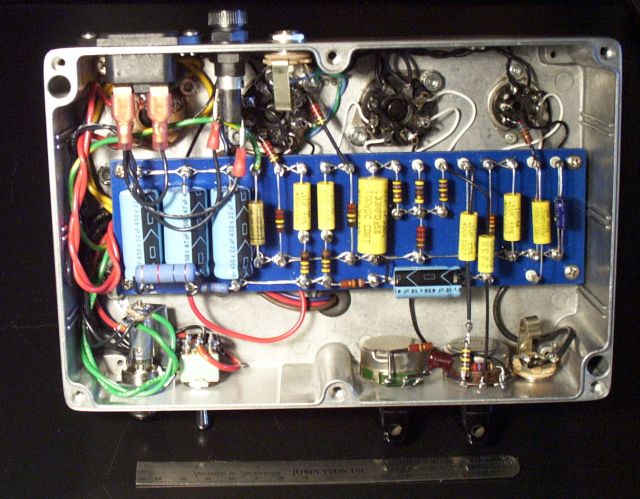
A layout for the circuit is available at AX84, but I chose to do my own turret board following the layout style of Doug Hoffman at Hoffman Amps, who supplied the Fender-style pilot lamp holder and 1/4" phone jacks. To save board space, I built the tone stack on the pots using a mirror image of Adam Alpern's beautiful illustration. I use Microsoft Visio to do accurately scaled board and component layouts to be sure everything will fit before cutting and drilling. Most of the hookup wire is 22 AWG solid core teflon from Skycraft Surplus, with 20 AWG stranded teflon for the filaments. I tried something new with the power toggle switch: a 3PDT center off unit controls mains power and HV standby with one switch. The down position is standby, which lights the filaments. Center is off, and the up position applies the both filament and HV. Standby lifts the transformer HV center tap from the chassis. Leaving the amp in standby for 10 seconds before powering off drains the filter capacitors completely.
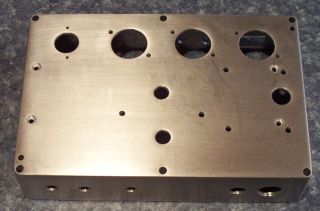
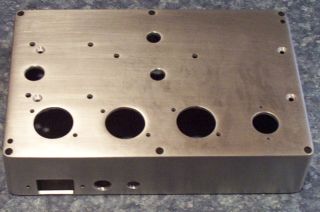
This is the second amp I've built into a Velleman G-124 die cast aluminum enclosure, 222mm x 146mm x 55 mm. At 3 mm thick, it's very sturdy, but it takes several hours of finish work to sand the outer surface into reasonable attractiveness. The die casting alloy doesn't anodize well, though powder coat paint may be a good durable alternative. Non-uniformity in the composition of the die-cast surface limits how well you can polish it - I took it to 220 grit silicon carbide paper followed with a ScotchBrite pad for a brushed look. The octal socket holes were made with a Greenlee chassis punch, the other control holes were made with a #4 Unibit in my $88 Delta drill press. My friend Arpad used his handy Bridgeport to mill the rectangular hole for the IEC power connector.
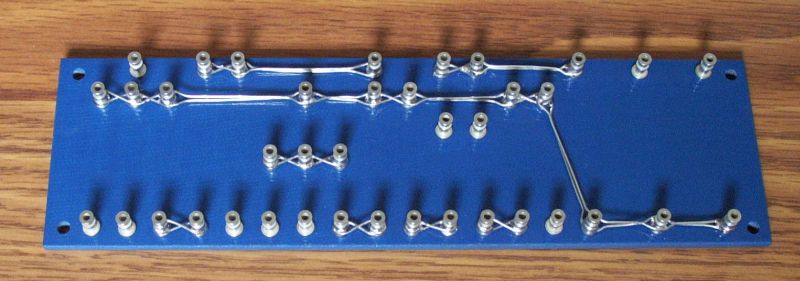
The turret board is 7.75" x 2.25" constructed on 0.125" G10-FR4 glass-epoxy (aka Garolite) from McMaster-Carr. The Keystone turret lugs are Mouser Electronics part 534-1509-4. These two-level terminals have a through-hole large enough to accomodate several component leads. Mouser also supplied the Mallory 150 coupling caps, Xicon power supply electrolytics, and Xicon power resistors. If you enjoy stuffing as much amp as possible into a tiny box, a taste I seem to have picked up from Adam Alpern and Mark Lavelle, you come to rely on the compact size of the Xicon high voltage axial electrolytics.
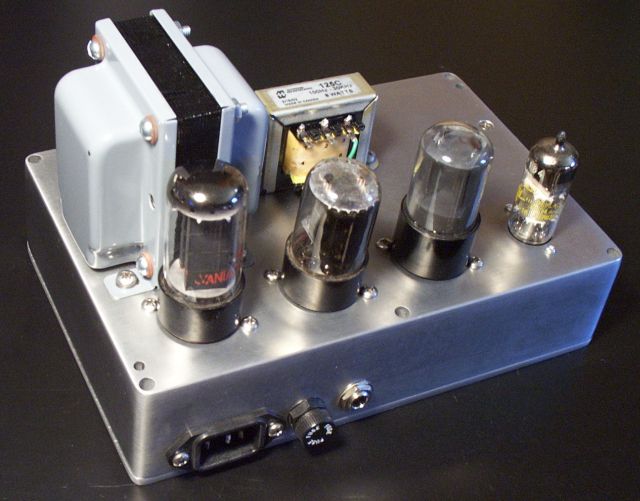
Tubes, from left to right:
Since the power transformer sported a 5V filament winding in addition to the 6.3V one, I decided to go with a 5Y3GT tube rectifier, instead of the silicon diodes used in the original. The relatively large voltage drop of the 5Y3 allowed me to use a 1K 5W power resistor after the first filter stage, instead of the 2K 10W resistor specified in the original. The first filter node sees 297VDC. Next comes the power tube, a 6SN7GT dual triode. This runs off the second filter node at 270VDC, and is cathode biased to draw 10 mA per section. Phase splitting chores are handled by a 6SL7GT in a conventional Schmidt pair configuration, run from 240VDC off the third filter node. The preamp gain stage is a 6EJ7/EF184, a plentiful and inexpensive (~$3) TV RF/IF pentode that works great in this design. Plate supply is 225V from the fourth filter node. I've substituted other small signal pentodes, including the 6EH7/EF183 and 6BX6/EF80 with good results.
I like the tone through a single EVM-12L in a ported box. I found it too midrange-heavy through a bandmate's open back cab with a 12" Groove Tubes Classic Clone speaker. It sounded sweet with the Weber P10R in my BF Princeton Reverb. I'll be testing it with the Jensen C10Q resissues in my BF Vibrolux Reverb, and a bandmate's Marshall 1960 cabinet in the coming weeks. One cool thing about these half-watt amps is the amount of air they can push through a full-size 4x12 cabinet.
The 6SN7 doesn't provide much clean headroom. I plan to build another Moonlight with a beefier power transformer (>80mA) capable of running a 6BL7GT twin triode power tube. The 6BL7 was used in TV's as the vertical oscillator/deflection amp, and can dissispate 12W, substantially more than the 7W combined plate dissipation of the 6SN7. I ran a 6BL7 in this amp for a minute or so (the 1.5A filament and 20 mA/section current draw are too much for long-term use with this transformer), and it seemed to offer significantly more headroom. Of course, it was louder when cranked, too.